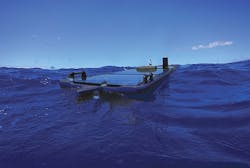Royal Navy uses networked unmanned surface vessels (USVs) for detecting and tracking submarines
SUNNYVALE, Calif., 1 Nov. 2016. The British Royal Navy has demonstrated the detection and tracking of manned and unmanned submarines using a long-endurance unmanned surface vessel (USV) called the Sensor Hosting Autonomous Remote Craft (SHARC) from Liquid Robotics Inc. in Sunnyvale, Calif.
Liquid Robotics experts used a networked set of four SHARC USVs equipped with advanced Boeing acoustic sensors. The SHARCs were deployed off the coast of Northern Scotland during the British Royal Navy's Unmanned Warrior 2016 demonstration in October.
Over the two-week demonstration, the four networked SHARCs exchanged data in real time to detect and track an advancing unmanned underwater vehicle (UUV), as well as a manned diesel submarine, Liquid Robotics officials say.
"Our work during Unmanned Warrior demonstrates without a doubt the practicality of using autonomous systems to provide real-time actionable intelligence to our warfighters," says Kory Mathews, vice president of autonomous systems at the Boeing Co. Defense, Space & Security segment in St. Louis.
Related: Liquid Robotics Wave Glider battles Hurricane Isaac
In September 2014 Liquid Robotics and Boeing signed a multi-year agreement. The companies used the Liquid Robotics Wave Glider USV to develop the SHARC, which delivers continuous maritime intelligence, surveillance, and reconnaissance missions for as long as one year without fuel or manpower.
The SHARC surface vessel is about the size of a surfboard and has solar panels for power generation and antennas for line-of-sight and satellite communications. Its low profile is extremely difficult to detect from surface ships or aircraft.
The SHARC uses the Liquid Robotics Wave Glider technology for propulsion, which dangles a set of wings on a tether about 20 feet below the surface vessel, which harvests wave energy for forward propulsion. The suspended wings also keep the surface vessel stable even in hurricane-force winds and waves. One operator on shore can monitor and control large fleets of SHARC USVs.
SHARC's capabilities demonstrated during Unmanned Warrior didn't stop at anti-submarine warfare (ASW). Two SHARCs had meteorological and oceanographic sensors to gather data for prediction models.
Related: Coast Guard looks for unmanned ocean vehicles to hunt smugglers, poachers, and icebergs
During the exercise the SHARCs operated 24/7 in harsh conditions unfavorable for manned operations -- waves of about 22 feet and winds of more than 60 knots -- to provide real-time data autonomously on weather and ocean conditions.
"We proved that SHARCs can augment the tedious and dangerous task of continuous maritime surveillance by our warfighters and provide critical real-time intelligence to commanders," says Gary Gysin, president and chief executive officer of Liquid Robotics.
For more information contact Liquid Robotics online at www.liquid-robotics.com, Boeing Defense, Space & Security at www.boeing.com/defense, or the Royal Navy at www.royalnavy.mod.uk.
Learn more: search the Aerospace & Defense Buyer's Guide for companies, new products, press releases, and videos
